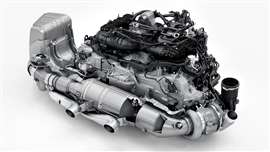Porsche files patent for six-stroke IC engine
23 September 2024
 Radical tech - could venerable six-cylinder boxer engine from Porsche 911 feature new system
Radical tech - could venerable six-cylinder boxer engine from Porsche 911 feature new system
There are some engine technologies which will fall outside our coverage remit – but are still worth checking out. In one such case, German sports car OEM Porsche has filed a patent application with the United States Patent and Trademark Office for a six-stroke internal combustion (IC) engine.
As most readers will know, the vast majority of engines use a four-stroke system – the suck, squeeze, bang, blow process used to convert chemical fuel energy into mechanical energy.
With this new patent, Porsche has outlined a system using the following pattern – suck, squeeze, bang, squeeze, bang, blow. Or in other words, the patent outlines a ‘method for a combustion machine with two times three strokes’. Which essentially describes a variable compression system using two different top and bottom dead centres.
This is not the first time an OEM has attempted to change top and bottom dead centres to improve IC performance. In 2017, Nissan unveiled its Variable Compression (VC) Turbo, an engine which uses a complicated system to achieve on-the-fly compression changes (between 8:1 and 14:1) with the goal of supplementing power and improving fuel economy.
The Porsche solution would be less complex. The first three strokes would maintain the standard four-stroke IC pattern. But from there, bottom dead centre would move lower to expose exhaust ports. As gas was vented, the next upstroke would compress the remaining air/exhaust mix. It’s not clear whether a second (possibly lesser) fuel injection event would occur, but once this was ignited the system would vent as normal and the cycle starts again.
The design could deliver benefits in two ways. In smaller engines, it could be used to make the most of a single fuel injection event, ensuring the maximum percentage of fuel is burned to reduce emissions. In larger engines, a full double burn could produce more power.
As it is, there’s no indication of whether Porsche is planning to use the tech, or if the OEM is only protecting the idea. But there are possible drawbacks. With a second fuel injection cycle there would be no emissions reduction, while additional gearing on the crankshaft would build friction.
The VC Turbo went on to receive a series of awards for its tech. Yet while the engine was fitted in about 450,000 cars, owners have reported issues such as stalling, through to premature engine failure. The Porsche solution is certainly less complicated, but such is the difficulty of making fundamental changes to otherwise proven tech, it will be interesting to see what the German OEM does with this – and whether it might offer benefits beyond automotive.
CONNECT WITH THE TEAM









